
A regular midwinter day for avalanche forecasters might start at 3:30 in the morning. Check the weather, see if there is any snow falling, record wind speeds, and synthesize the impact on the snowpack in the form of an online avalanche forecast.
From there, avalanche forecasters are often in the field, whether by snowmobile or skis, making observations, digging snow pits and validating aspects of their forecast.
For the 70 professionals employed by the USDA Forest Service Avalanche Program, this winter may be more taxing. On September 16, 2024, the Chief of the United States Forest Service (USFS), Randy Moore, announced that for Fiscal Year 2025, there would be a hiring freeze on temporary seasonal employees, better known as 1039s. While the initial hiring freeze exempted wildland firefighters, none of the 15 temporary seasonal avalanche workers were spared.
The announcement came on an all employee call in which USFS Budget Director Mark Lichtenstein said, “We do have pretty concrete evidence that this year, FY25, no matter which way, no matter what happens, will not likely be a very robust budget environment.”
Pushback was swift. On October 4, 2024, the Winter Wildlands Alliance (WWA), a nonprofit organization working to inspire and empower people to protect America’s wild snowscapes, sent a letter to Moore asking him to grant avalanche centers an exemption from the hiring freeze. Additional signees of the letter included 41 organizations and business involved with backcountry winter recreation, from Anchorage, Alaska, to Conway, New Hampshire. Thirty-three members of Congress were copied on the letter to Moore.
WWA also asked that tours of duty, the amount of two week pay periods established in each seasonal position, be extended as necessitated by the demands of the winter season. Avalanche forecasters are generally given 13 to 18 pay periods but were previously given extensions to complete work—such as website updates and reports—that gets brushed under the rug amidst the flurry of peak season.
WWA Policy Director Hilary Eisen expressed concern in a press release over the 1039 hiring freeze and employment restrictions, saying it would be “detrimental to the functionality of the fourteen Avalanche Centers operated by the U.S. Forest Service and result in significant negative impacts to public safety this winter.”
Ski touring is one of the fastest growing sports in the U.S. and with more people in the line of fire, avalanche forecasts and outreach are all the more important.
“In a lot of ways it’s good that backcountry skiing is more accessible,” an avalanche forecaster who requested not to be named told Backcountry. “But I do feel like, with that, there’s been less of a push to necessarily have the understanding of the snowpack to enter avalanche terrain. You just have more people and more people are a hazard as well, right? For you, if you’re out touring in the backcountry and there are more people, that’s a significant hazard to you, even if you’re totally dialed yourself.”
Avalanches are fickle, and even forecasters find themselves in danger. Last spring, a forecaster with the Colorado Avalanche Information Center was rescued after being buried against a tree. Earlier that season, an Oregon avalanche forecaster was killed in a slide.
Beyond just public safety, the undue burden placed on the remaining avalanche forecasters is a concern. The same anonymous forecaster said that 1039s often perform an equal role in forecasting and outreach compared to permanent forecasters.
“Just losing one of those people would be pretty significant,” the forecaster said. “With our kind of workload, there’s no way the other people can compensate for that.”
Forecasters’ workloads don’t always end in the field. After a day of logging observations, they might give snowpack talks until 8 p.m. at a local community centers. Their position often takes them across the state too, giving avalanche regions without historic forecasting basic exposure to snow science—how to read a forecast, dig pits and even reach out to avalanche centers.
This community outreach is often driven by local community partners. There are 14 USFS avalanche centers in the United States and according to Scott Owen, a USFS National Press Officer, each center operates as a public-private partnership. The USFS provides funding for technically proficient staff and in return, local organizations and sponsors engage in community outreach and fundraising. For example, the Wyoming-based Bridger-Teton Avalanche Center’s (BTAC) nonprofit partner is the aptly named Bridger-Teton Avalanche Center Foundation, but they’re also sponsored by Jackson Hole Mountain Resort, Stio and Ski-Doo, to name a few. Without federal support, however, these public avalanche centers may struggle to provide the same programming.
Since the hiring freeze was announced, lobbying from local communities and the WWA combined with direct appeals has resulted in exemptions to four avalanche centers: The Northwest Avalanche Center in Washington, the Utah Avalanche Center, Gallatin National Forest Avalanche Center in Montana, and BTAC.
Even with exemptions, there is concern about the lack of investment in seasonal workers and its ramifications for the future of the USFS. Jamie Tommins, a former 1039 employee for the USFS and writer of a substack titled Patrol, thinks the culture could suffer.
“As long as the institutional memory goes back of people that I ever worked with, like, you know, old guys, it’s always been you start as a seasonal and that’s how you earn your stripes and get a permanent job,” Tommins explains, speaking broadly. “If you lose all the seasonals, then that’s a generational hit, even if it’s just for a couple seasons. It will leave a big gap in the experience and the skilled workforce.”
Hopefully, for the avalanche centers for which no exemption has been made, the quality of product that reaches backcountry users, be it a forecast or a beer plus beta event, remains the same. For the greater backcountry community, it’s important, now more than ever, to get involved, advocate for avalanche centers and stay educated.










Related posts: